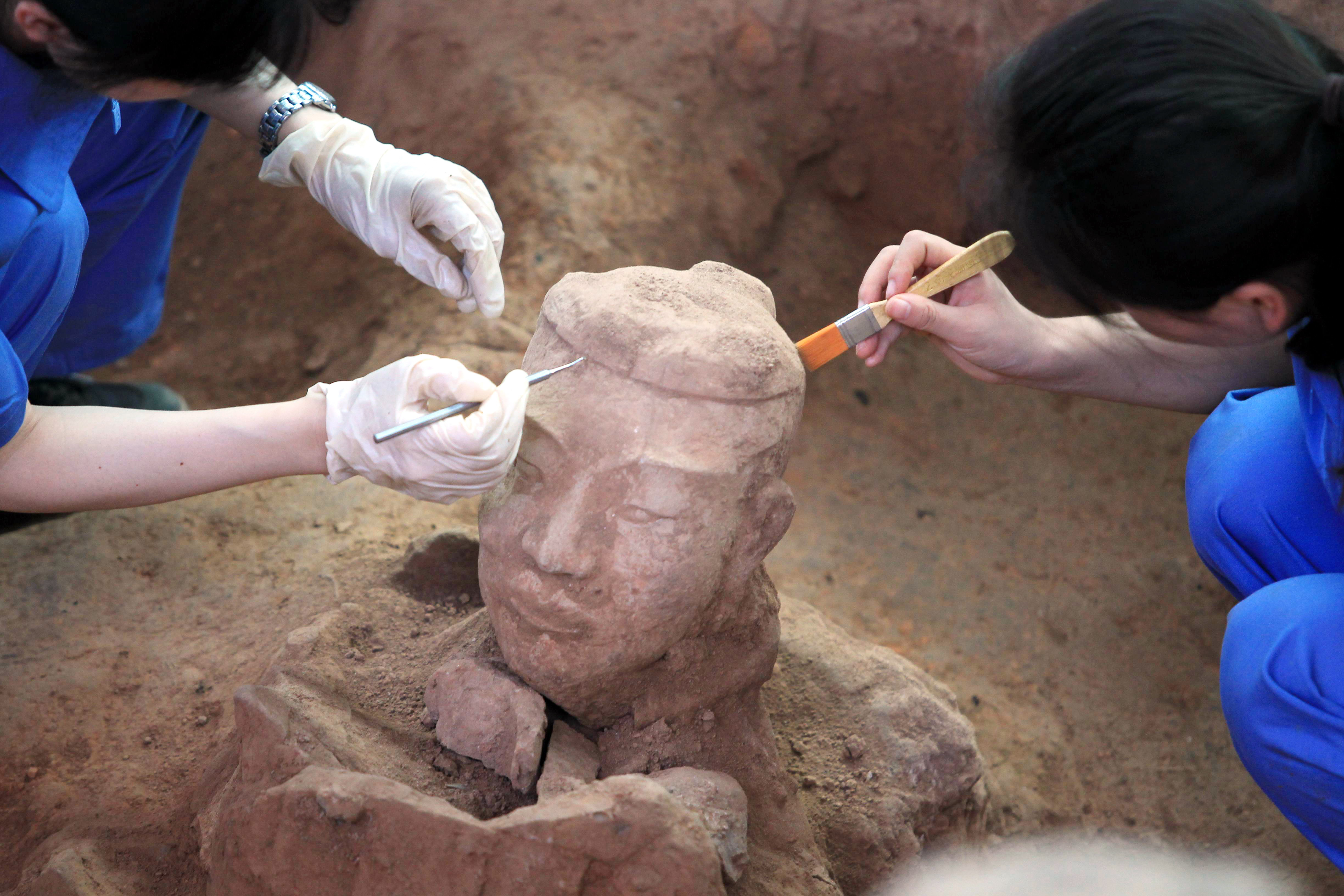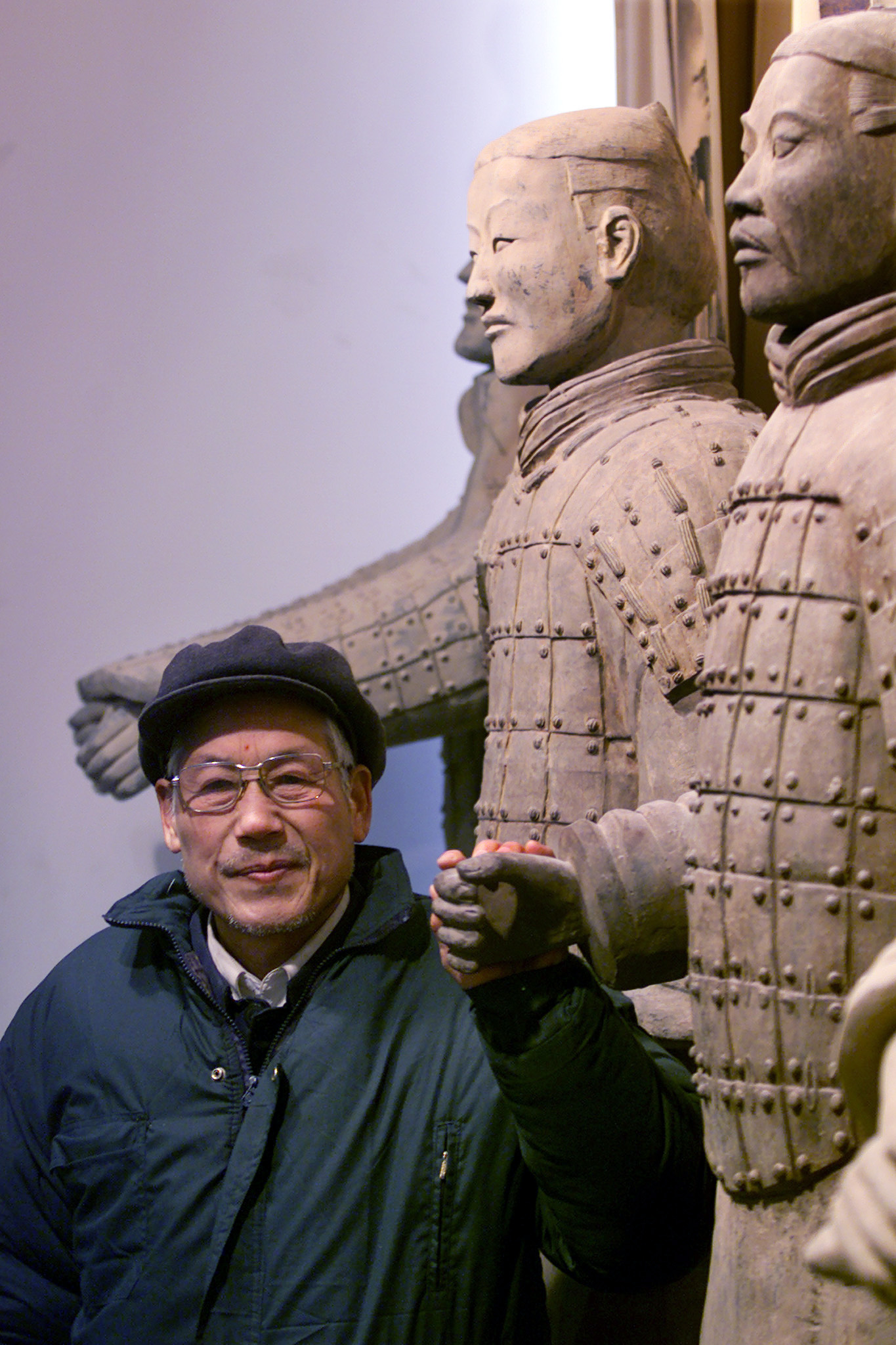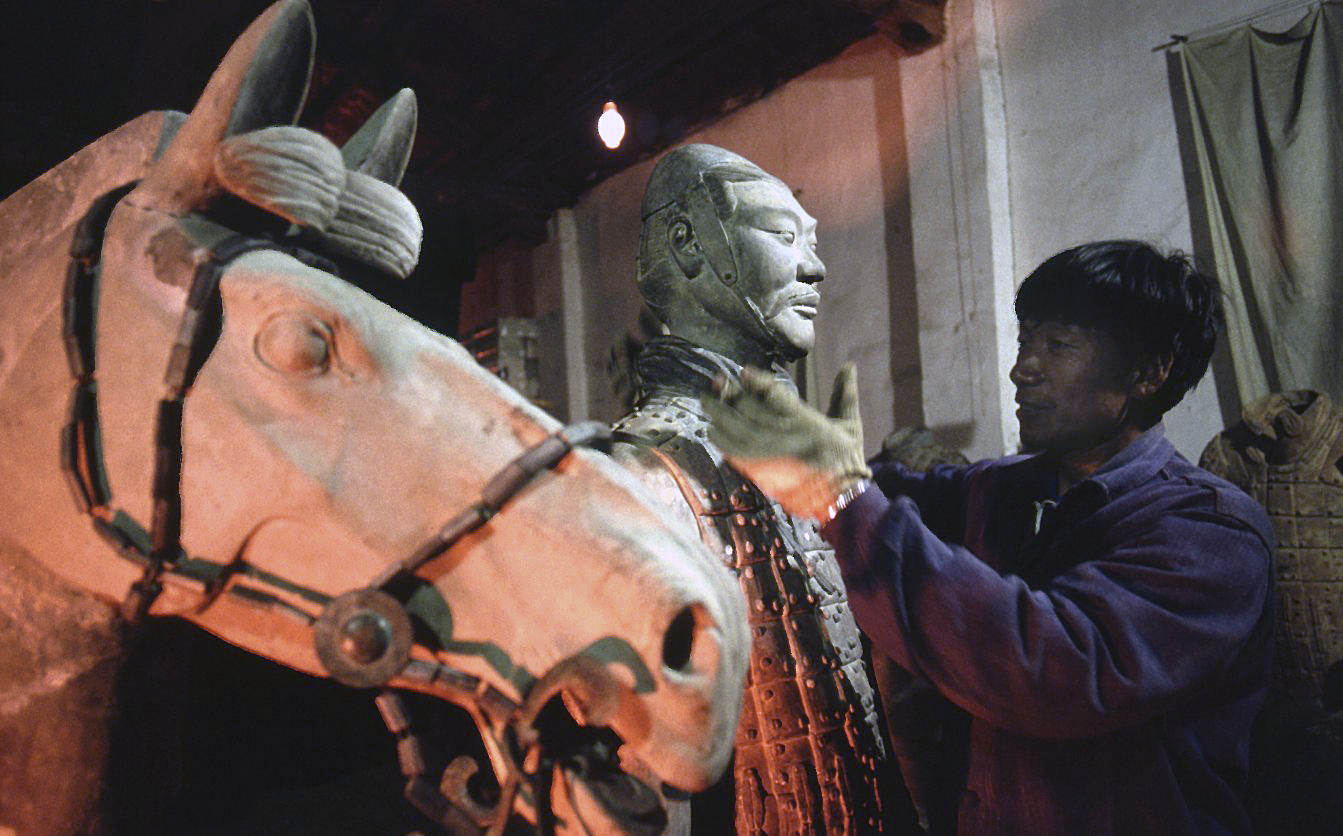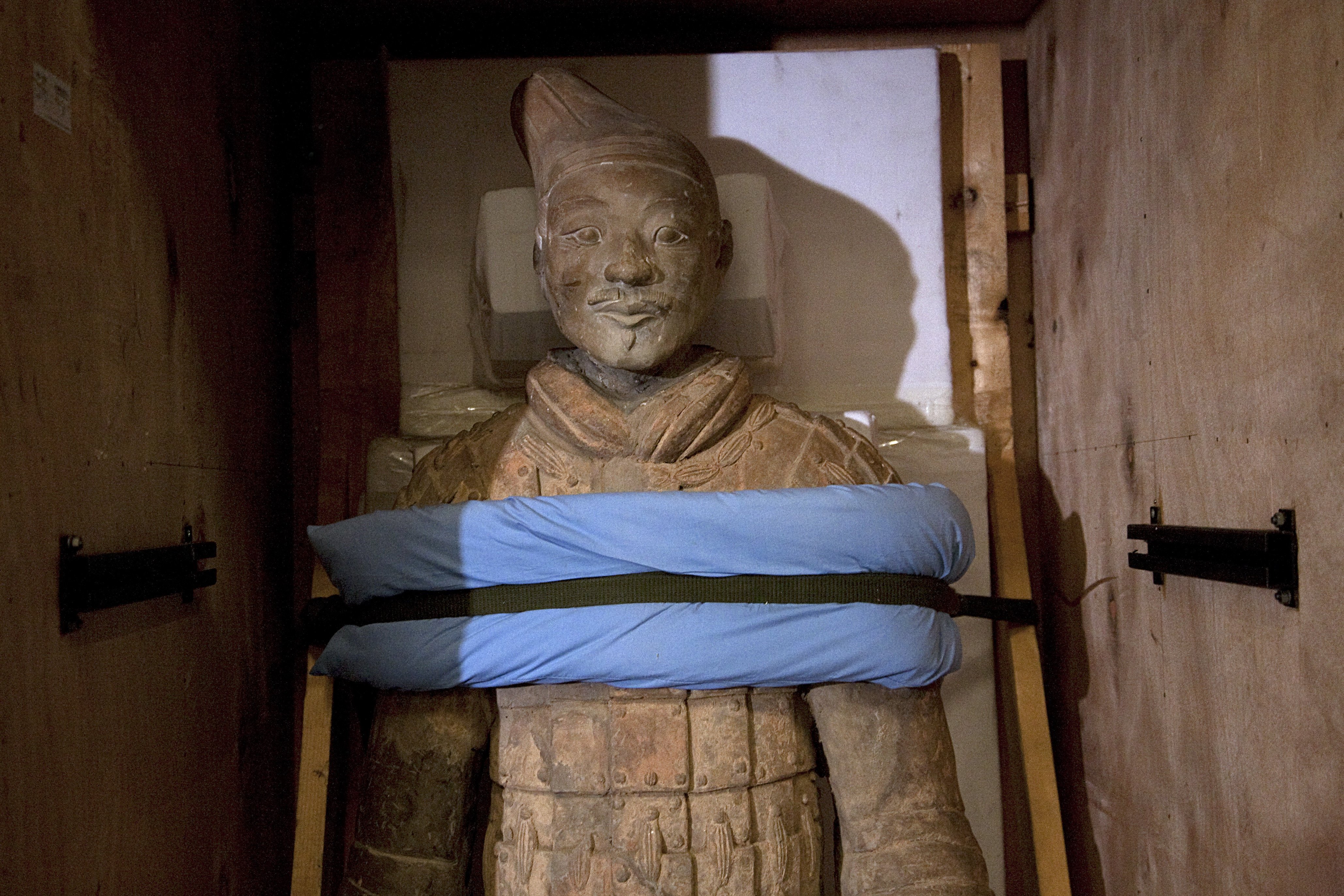The man who dug a well and found an army

When peasant Yang Zhifa found a piece of old terracotta as he dug a well, he thought he’d stumbled on a disused kiln which could supply him with free jars. How wrong he was: it turned out to be the first warrior of the famous Chinese terracotta army.
A selection of the 2,000-year-old Qin warriors, discovered in 1974 in China’s central Shaanxi province, are now on display in Bern’s history museum. swissinfo.ch tracked down Yang, who is now 75, and spoke to him by phone.
It was March 1974, not long after the Chinese New Year, and as it was particularly dry at the time, Yang’s production unit decided to dig a well to water the crops of the cooperative farm.
“At first the digging went well. The second day we hit hard red earth. The third day, my hoe dug out the neck of a terracotta statue without a head, but the opening at the bottom was about size of a bowl,” he recalled.
“I commented to my workmate that it was probably the site of an old kiln. He advised me to dig carefully, so that we’d be able to dig out any old jars and take them home for our own use.”
As they went on digging, the peasants came across the shoulders and torso of a statue. So it evidently wasn’t a kiln, they thought, but a temple. Then they realised that it was a complete body, apart from one leg that had been cut off, and the missing head.
As they went on digging, they turned up bronze items. One of Yang’s colleagues teased him: “You like a nice pipe, and these things will be worth quite a bit of money. You’ll be able to swap them for tobacco.”
The “First Qin Emperor”, Qin Shi Huangdi ,who lived from 259 to 210 B.C. unified China in 221 B.C. when he put an end to the so-called Warring States period, when the country was made up of different kingdoms.
The centralised authoritarian regime which he established lasted for more than 2000 years.
He standardised the writing system, currency and measures, and is regarded as the father of the Great Wall of China.
He was buried with thousands of terracotta warriors.
Former French president, Jacques Chirac, described his mausoleum as the “eighth wonder of the world”.
Suspicious villagers
“It was the middle of the Cultural Revolution at the time, and everything was topsy-turvy in the villages. People had gathered round and were watching us. When the older ones saw these ‘statues of gods’ and the bronze objects we had dug up, they weren’t at all pleased. They said they were part of the local feng shui, and that digging them up would do no good either to the village or to us.”
But Yang had spent six years in the army and knew something about ancient objects.
“People had always said that the tomb of the Qin emperor covered an area of just over 9 hectares and that our village was about two kilometres from the mausoleum. These objects could be of historic interest. So I called some women and harnessed up three two-wheeled carts to transport them […] to the Lintong district museum several kilometres away.“
Yang wasn’t too sure what the museum would say about his find. “If they aren’t of any historic interest, I’ll throw them into the river, have a wash and go home,” he thought as he and his colleagues transported their unusual load.
The experts at the museum recognised the fragments and the “statue of the god” as dating from the Qin dynasty – the third century B.C. – and that they were therefore extremely valuable.
“They paid us CNY10 (yuan) per cart, so a total of CNY30. We were really happy to get so much for having brought three carts of terracotta,” said Yang. At the time CNY10 was the equivalent of an annual salary in poor rural areas.
When they got back to the village they handed the money to their production unit, as was required under the collective system. Each one of them was awarded five points – the equivalent of half a day’s work – or 13 fen (a fen being a hundredth of a yuan) that they could use to buy food or other goods. At first that was their entire reward.

Hour of glory
The authorities then decided to build a museum on the site of the mausoleum. The villagers – including Yang – were displaced. He received 5,000 yuan in compensation for his 167 square metres of land.
He moved to a new village, called Qinyong (meaning “Qin warriors”), six kilometres from the museum. He was given a three-room flat, similar to the ones allocated to other relocated villagers. But they were angry with him: if they had had to leave their homes it was “because of him”, he explained. To get away from their hostile looks and remarks, he moved about a kilometre away.
When he thinks about it now, it didn’t really make much difference to his life. But he says that the discovery of the site and the reforms introduced by the authorities led to a rise in the standard of living and some of the villagers have been able to make money by setting up businesses.
But Yang doesn’t have a head for that sort of thing. The museum gave him a job signing autographs for visitors. “At first I was earning CNY300 a month. By the time I retired it was 1,000.”
Yang had his hour of glory when Bill Clinton visited the museum and asked for his autograph. The former US president isn’t the only world leader Yang met. He can’t remember all the names, but he has their photos on his wall.

More
Moving China’s Terracotta Army
Philosophical
When he stopped working at the museum, Yang found himself with practically no income. But he is philosophical about it.
“Whether it’s fair or not, I can’t do anything about it. I’m only a simple peasant,” he commented, but he is not unhappy either. “There were too many people at the museum. Sometimes I didn’t feel too well after working all day.”
The museum now draws millions of visitors a year, and earns some CNY480 million from them (about CHF72 million).
But few people still remember Yang. His name does not even appear on the explanatory board at the entrance to the display, which says simply that the terracotta army was discovered by local peasants.
The People’s Daily wrote that “peasants don’t know anything about science. It’s impossible that they should have discovered anything,” said Yang.
“That’s life. Even if there is a lot of injustice in society, there’s no point in getting angry about it.”
And as he pointed out, the discovery of the “eighth wonder of the world” may not have made him rich, but it still makes him proud.
An exhibition about the Qin emperor’s mausoleum and the terracotta army is being held in Bern’s history museum from March 15 to November 17 2013. It is the first major exhibition on the subject ever held in Switzerland.
Ten original statues and 220 other objects are featured in the exhibition, which is entitled “Qin – the Eternal Emperor and his Terracotta Warriors”.
The mausoleum of the Qin emperor is located in Lintong district, about 30 kilometres from the city of Xi’an, in the central province of Shaanxi. The terracotta statues of warriors and horses are life size, and number about 8,000 in all, although only 1,500 have been excavated so far.
The statues fall into different categories: generals, foot soldiers, soldiers in armour, kneeling archers etc.
Thousands of real weapons have also been found, as has the emperor’s bronze chariot, which is on display at the mausoleum museum.
The site was designated as a Unesco world heritage site in 1987.
(adapted by Jie Guo Zehnder and Julia Slater)

In compliance with the JTI standards
More: SWI swissinfo.ch certified by the Journalism Trust Initiative

You can find an overview of ongoing debates with our journalists here. Please join us!
If you want to start a conversation about a topic raised in this article or want to report factual errors, email us at english@swissinfo.ch.